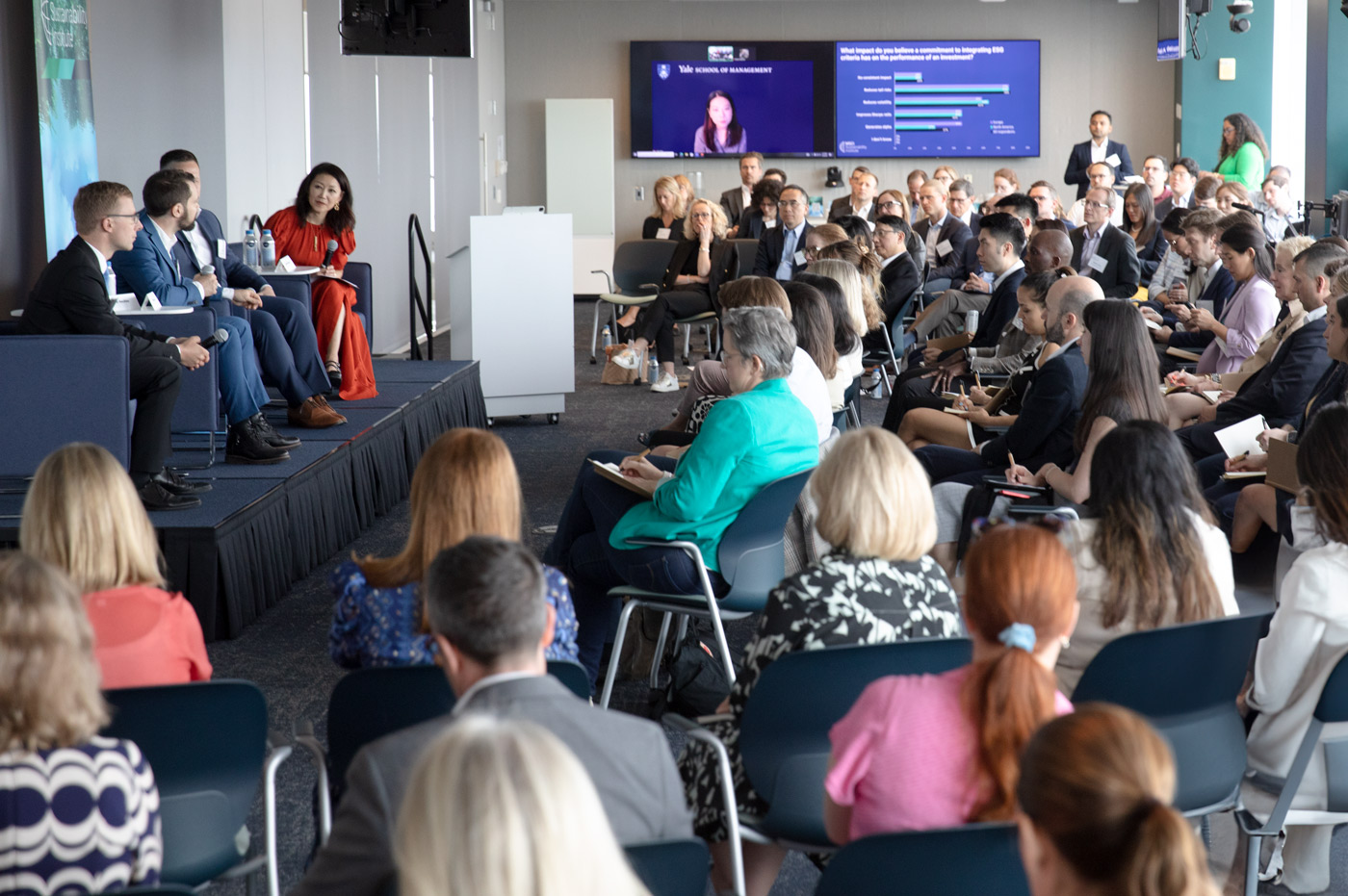Antimicrobial resistance (AMR) fueled by indiscriminate use of antibiotics represents among the greatest threats to global public health. How can investors address the risks and opportunities that AMR presents?
This question took center stage at a roundtable hosted by the MSCI Sustainability Institute in collaboration with the Access to Medicine Foundation and the FAIRR initiative. The discussion followed the release of a new guide to AMR for investors, co-authored by the three organizations.
The roundtable convened key leaders from finance, business and healthcare to explore how investors can tackle the problem of AMR, which impacts a range of industries and threatens to shrink global growth nearly 4% by 2050.
Held under Chatham House rule to encourage candor, the convening surfaced key areas of focus for investors in the run-up to the annual meeting of the United Nations General Assembly, which will convene a high-level meeting on AMR during its seventy-ninth session in New York this September.
Below are highlights from the conversation, which focused on guiding investors in formulating strategies to mitigate the risks that AMR poses to lives and investment portfolios.
Engagement with companies and policymakers
Think of AMR as a market failure, participants stressed. “There’s only so much that companies can do if the political and policy landscape isn’t supporting them,” said one. “Until we get policymakers to reframe the whole architecture around this we’ll be pushing rocks uphill.”
- “We take a twinned approach that looks at both engagement with companies and with policymakers,” agreed another investor. “They’re intertwined.”
- “We focus on engagement and awareness-raising, which is why the new guide for investors is so useful,” said another. The questions for use in engagement that the guide lists would “allow you to walk into a meeting with an investee company and have a high quality conversation with even an eyeball of the report,” agreed another.
- “When we tender a new mandate, we ask our managers how they engage with underlying companies,” said one asset owner, who noted that they also engage directly with companies, join with other asset owners to highlight AMR in stewardship, and work to highlight the risks of AMR with policymakers.
- “We are looking at AMR efficacy,” explained another, citing the benefits to both health outcomes and companies when antibiotics are used effectively.
- Several speakers underscored the connection between effective antibiotics and improved health outcomes. “Having effective antimicrobials makes a difference in the prognosis for the patient,” said a clinician in attendance. “It’s difficult to treat someone with cancer if they have an infection.”
Challenges in drug development
The challenge is to find antibiotics that will have proved both safe and effective, explained participants from the pharmaceutical industry, noting the decade or more it can take to bring a drug to market.
- “The focus needs to shift to finding drugs that have a new mechanism of action,” suggested one, noting that AMR develops quickly. “Bioinformatics and genomic tools can help with that.”
- Bacteria have complex resistance mechanisms, noted another. “We need to have antibiotics that can penetrate a biofilm (a complex community of bacteria),” citing the need for drugs that target such mechanisms “from multiple avenues.”
- There can be an inverse relationships between lowering the risk of developing drugs and maximizing their efficacy, said another. “”We’ve not seen a new class of antibiotics in 30 or 40 years,” she observed. “Everything we’ve seen in recent years is an improved version of what we already have. You’re not going to get a 100% efficacy drug if that’s the pathway you’re following.”
- “It’s a very difficult value proposition,” noted another, citing the journey from discovering a drug of promise in the lab to establishing its safety and bringing it to market. “Who will back you financially if you they don’t know how they will recoup their investment,” she noted. “The inability to translate from the lab to a formulation that will work in humans is the first point at which we have market failure.”
- The process of bringing new drugs to market would accelerate if national regulators were to talk with one another, several participants said. “When you put a data package in front of the Food and Drug Administration, you redo it from scratch for another regulator,” she said, adding that the FDA may classify a drug as a biologic, while the European Medicines Agency may classify it as something else. “It’s hard to scale and commercialize if we can’t get regulators to agree,” she added.
- Engaging with regulators can help, someone suggested. “Even though regulators are responsible for reviewing data provided to them, they can be contacted in advance for advice or guidance as to what they expect to see,” she observed. “Engaging with them early on can avoid rejection.”
How investors can help
Disclosure of financial information tied to the sale of antibiotics or AMR-related risks needs to improve dramatically, suggested one speaker. “Disclosure is abysmal,” she observed. “You cannot compare this to climate change or biodiversity. Understanding corporate practices is almost impossible because there’s almost no data to work from.”
- Investors can advocate for greater clarity in guidance on the use of antibiotics in livestock, noted one participant. “We also need access to a much broader portfolio of alternatives, especially vaccination development. We are not seeing enough funding on that.”
- Delinking the volume of drugs sold from public reimbursement for development can help, suggested one participant, noting both the early success of that approach in the U.K. and the pendency in the U.S. Congress of legislation that would follow a similar approach to innovation. “We need to address this through reimbursement at the infection level, which would be a positive,” he said.
- “Reimbursement is a huge barrier,” agreed another. “You have immunosuppressed patients who are the first victims of AMR, but if you can’t prove your medicines work on people who aren’t going to die you’ll never get reimbursed.”
- Some participants called for an intergovernmental panel on AMR modeled along the lines of the United Nations Intergovernmental Panel on Climate Change. “We need to push behind the will to get something like that at UNGA,” one urged.
- “The impactful opportunities are all going to be in the private markets,” suggested another participant, citing the challenge of investing for impact in secondary markets. “Companies are doing such a range of different things. You’re spreading your money around too much. We find that across the whole health sphere, not just AMR.”
The importance of access
Access, not resistance, is the primary problem in developing countries, suggested several participants. “In sub-Saharan Africa, the dominant forms of infection are susceptible to most antibiotics,” one noted. “So it’s not about resistance. You may see a greater health impact with greater use of antibiotics.”
- “There’s excess and there’s access and they’re not the same thing,” agreed another. “Rational use is different than restricting access.”
- “In most of the world we are using the wrong antibiotic because we don’t have the right one available,” noted another, citing the need “to get the right antibiotic to the right population at the right time.” “These are the questions for investors to be asking,” she added.
- “We talk about a just transition for climate change, but it’s a real discussion for AMR as well,” another participant said.
Next steps and the way forward
The first step for investors is to raise awareness by communicating their concerns over AMR, advised one investor. “We need conversations with corporates to express how concerned we are as well as collaboration with other stakeholders to show them we’re a lever they should use.”
- If they haven’t already, investors should sign the public statement developed by Investor Action on AMR (IAAMR), which outlines seven key asks of policymakers to consider ahead of the UNGA next month, recommended one participant.
- The G7 countries also need to follow through on commitments to incentivize AMR research and development, she noted, calling for asset owners to raise the issue of AMR with portfolio managers. “Every portfolio manager has some exposure,” she suggested, citing people in their own families whose cesarean section or treatment for cancer would not have been possible without antibiotics. “There’s always an angle and AMR is one of the easiest topics to get buy in for,” she added.
- At least one participant disagreed. “My experience with portfolio managers is the opposite,” she said. “If they manage funds that have ESG clients, perhaps, but for more traditional portfolio managers, it’s about how this impacts the share price or the value of the company.”
- That’s where both “broader efforts of stewardship” and consultants can help, suggested another. “Requests for information and due diligence inquires” to address AMR illustrate client demand, she stressed.
- Engaging patients is also an essential when it comes to combating AMR, suggested the clinician who advocated for a focus on efficacy. “I challenge everyone to think that AMR could not impact something in their portfolio,” he added. “Look at the impact of infection on your assets.”
Roundtable participants
Access to Medicine Foundation
Amundi
AMR Action Fund
Aviva Investors
British Society for Antimicrobial Chemotherapy (BSAC)
Columbia Threadneedle Investments
Council on Ethics
EdenTree Investment Management
FAIRR Initiative
Federated Hermes Limited
Franklin Templeton
Impact Investing Institute
IQVIA
Legal & General Investment Management Ltd.
M&G
MSCI
Ninety One
Novartis
Trinity College, Cambridge
Reddington
Regeneron
Royal London Asset Management
Sanlam Investments
Storebrand Asset Management

